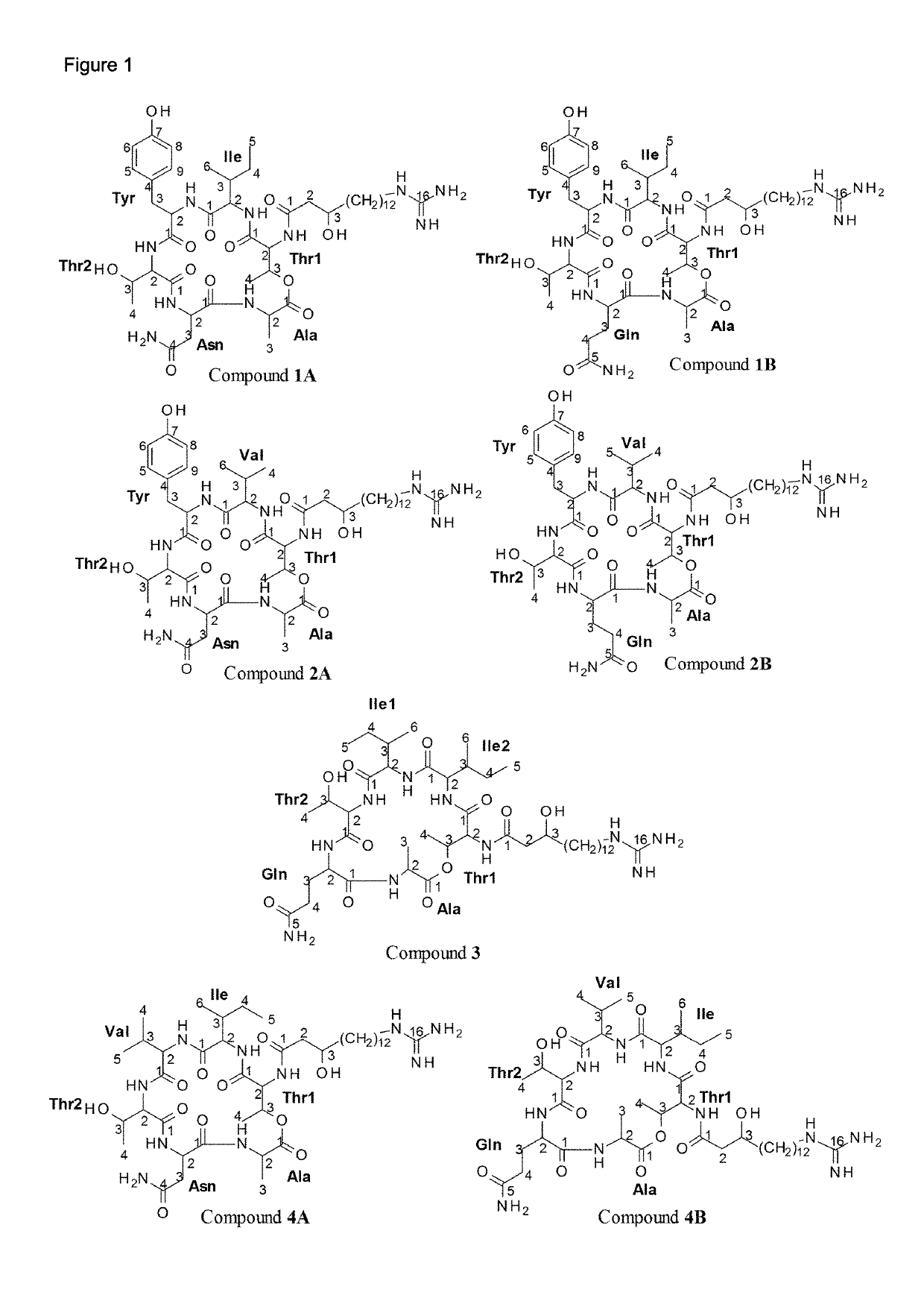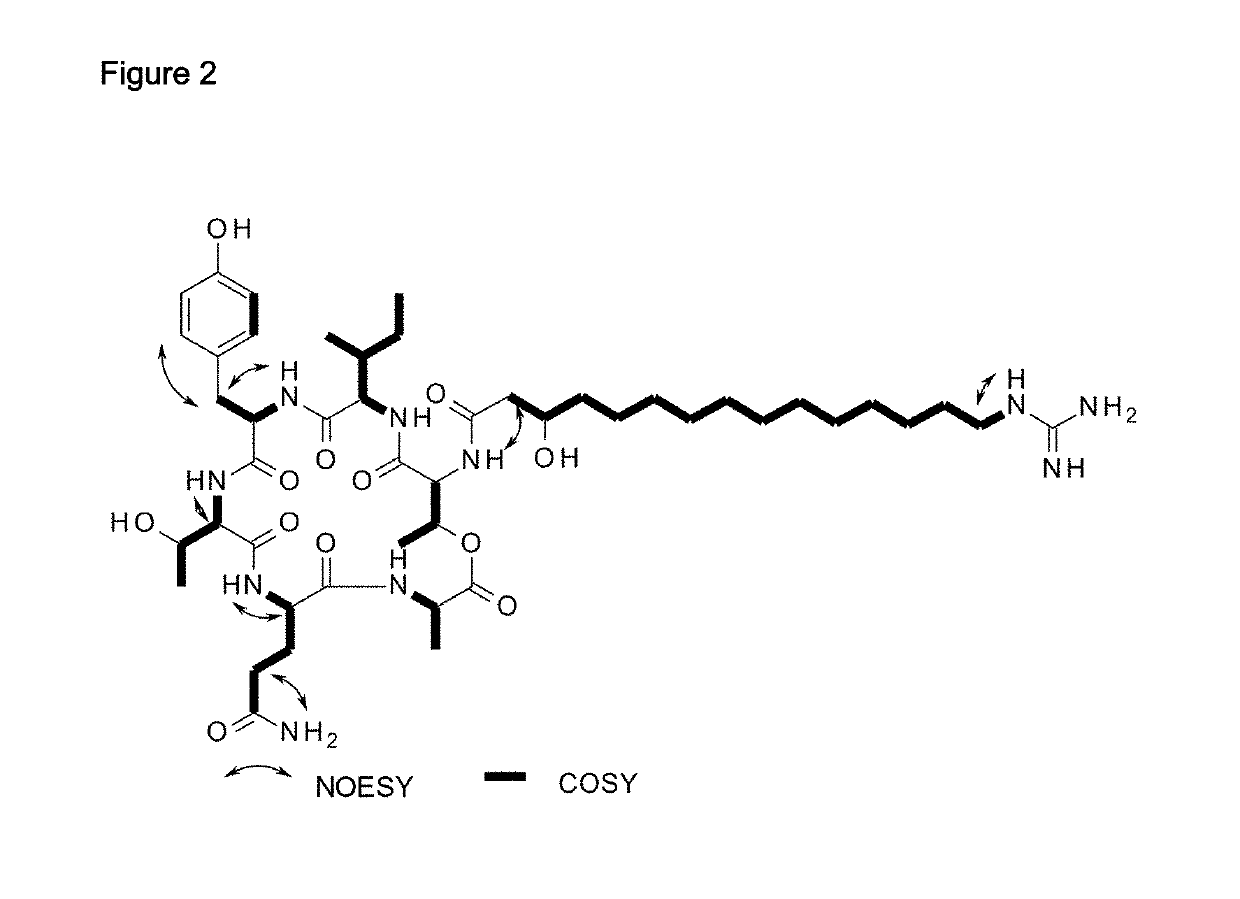Mixtures and compositions comprising paenibacillus strains or fusaricidins and chemical pesticides
a technology of chemical pesticides and mixtures, which is applied in the direction of biocide, seed immunisation, microorganisms, etc., can solve the problems of variable efficacy, inability to effectively control these fungi or pests with the active component in question, and slow speed
- Summary
- Abstract
- Description
- Claims
- Application Information
AI Technical Summary
Benefits of technology
Problems solved by technology
Method used
Image
Examples
example 2.1
quencing
[0518]The 16S rRNA gene sequences of the Paenibacillus strains were determined by direct sequencing of PCR-amplified 16S rDNA at the DSMZ, Braunschweig, Germany.
[0519]Genomic DNA extraction was carried out using the MasterPure™ Gram Positive DNA Purification Kit from Epicentre Biotechnologies according to the manufacturer's instructions. PCRmediated amplification of the 16S rDNA and purification of the PCR product was carried out as described previously (Int. J. Syst. Bacteriol. 46, 1088-1092, 1996). Purified PCR products were sequenced using the BigDye® Terminator v1.1 Cycle Sequencing Kit (Applied Biosystems) as directed in the manufacturer's protocol. Sequence reactions were electrophoresed using the 3500×L Genetic Analyzer from Applied Biosystems. Sequence ambiguities may be due to the existence of several cistrons encoding 16S rRNAs with different sequences within a single genome (J. Bacteriol. 178(19), 5636-5643, 1996).
[0520]The resulting sequence data from the strains...
example 2.2
nalysis
[0531]Standardized, automated ribotyping is performed using the Qualicon RiboPrintersystem. The RiboPrinter system combines molecular processing steps for ribotyping in a stand-alone, automated instrument. The procedure includes cell lysis, digestion of chromosomal DNA with restriction enzyme EcoRI, separation of fragments by electrophoresis, transfer of DNA fragments to a nylon membrane, hybridization to a probe generated from the rrnB operon from E. coli, chemiluminescent detection of the probe to the fragments containing rrn operon sequences, image detection and computerized analysis of RiboPrint patterns (Food Technology 50(1), 77-81, 1996; Proc. Natl. Acad. Sci. USA 92, 5229-5233, 1995; Int. Journ. Syst. Bact. 44(3), 454-460, 1994).
[0532]Ribotyping has been executed by the DSMZ, Germany with the Paenibacillus strains Lu16774, Lu17007 and Lu17015 in comparison to the P. peoriae strain BD-62 using the restriction enzyme EcoRI. The resulting patterns have been compared usin...
example 2.3
al and Physiological Characterization
[0535]The strains were characterized at the DSMZ in analogy to methods described in Gordon, R. E., Haynes, W. C. & Pang. C. H.-N. (1973): The Genus Bacillus, Agriculture Handbook no. 427. Washington D.C.: US Department of Agriculture. The results are given in Table 4.
TABLE 4Characterization Data of the Paenibacillus strains of the inventionand comparison to known Paenibacillus peoriae strain NRRL BD-62.Paenibacillus strainsIdentificationLu16774Lu17007Lu17015BD-62Characteristicscell formrod-shapedrod-shapedrod-shapedrod-shapedwidth [μm]0.9-1.00.9-1.00.9-1.00.9-1.0length [μm] 3−>5.0 3-5.0 3-5.02.5-5.0ellipsoid spores++++swollen sporangium++++Catalase++++Oxidase−−−−anaerobic growth++++VP reaction++++pH in VP-Medium5.25.74.85.2maximum temperaturepositive growth at ° C.40404040negative growth at ° C.50505050Growth in:Medium pH 5.7++++NaCl 2%++++NaCl 5%−−−−NaCl 7%−−−−Acid formation from:D-Glucose++++L-Arabinose++++D-Xylose++++D-Mannitol++++D -Fructo...
PUM
 Login to View More
Login to View More Abstract
Description
Claims
Application Information
 Login to View More
Login to View More - R&D
- Intellectual Property
- Life Sciences
- Materials
- Tech Scout
- Unparalleled Data Quality
- Higher Quality Content
- 60% Fewer Hallucinations
Browse by: Latest US Patents, China's latest patents, Technical Efficacy Thesaurus, Application Domain, Technology Topic, Popular Technical Reports.
© 2025 PatSnap. All rights reserved.Legal|Privacy policy|Modern Slavery Act Transparency Statement|Sitemap|About US| Contact US: help@patsnap.com



